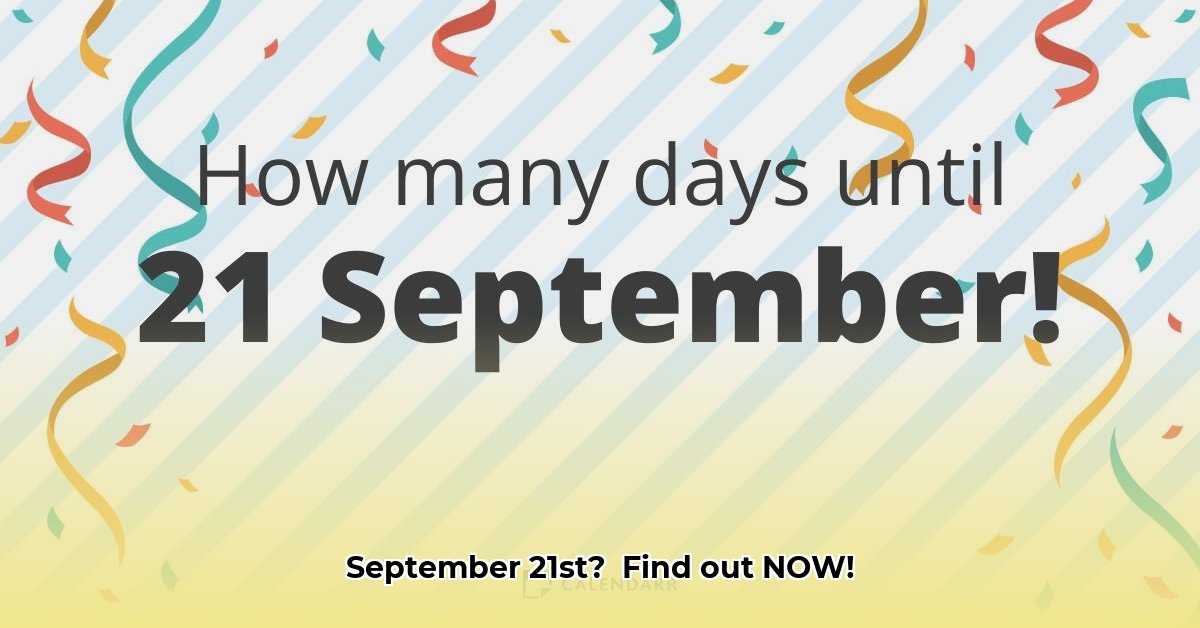Ever wondered how many days are left until September 21st? It might seem like a simple question, but figuring it out can be trickier than you think! For similar date calculations, check out this helpful guide on calculating days until a date. This guide will show you exactly how to calculate the days remaining, no matter what date it is. We’ll cover different ways to count down, explain why time zones matter, and make sure you always get the right answer. We’ll even show you how to avoid common mistakes, so you’ll never be caught off guard again. Let’s get started and find out how many days until September 21st!
Demystifying the Days Until September 21st Calculation
So, you’re wondering how many days are left until September 21st? It’s a simple question, right? Well, not quite. Getting the exact number involves a little more than just pointing at a calendar. Let’s dive in and explore why a seemingly straightforward calculation can have nuances. We’ll look at different calendar dates and how they influence the countdown process.
Why the Countdown Isn’t Always Straightforward
Imagine you’re planning a big event on September 21st. You want to know precisely how much time you have left to get everything ready. You might fire up your favorite online calculator, and it’ll spit out a number, maybe something like 127 or 128 days. But why the small difference? It all comes down to a few subtle details that might make the difference during the planning phase.
Factors Influencing the Countdown: Time Zones and Precision
Several factors influence the exact countdown:
- Time Zones: It’s All About Perspective. Think about it: If you’re in Los Angeles, it’s still early in the day while someone in London is already catching the sunset. Those few hours can add up, changing the calculated number of days. Time zone differences impact calculation accuracy, making calendar calculations complex. When coordinating with international teams, this becomes especially important.
- Precision Matters: The Nitty Gritty of Seconds. Some calculators are more precise than others, paying attention to seconds and even fractions of seconds in their calculations. These tiny differences in individual time measurements accumulate and can give you slightly different results. It’s like measuring a room with a tape measure – you’ll get slightly different results with different tape measures.
- Different Ways to Count: Math Methods Vary. Different calculators may use slightly different mathematical approaches to determine the number of days. These differences in their underlying “recipes” can lead to slightly different answers. Understanding how a particular calculator works is crucial for interpreting its results.
- Calendar Systems: More Than Just One Way. While we all mostly use the Gregorian calendar (the internationally accepted civil calendar), other systems exist. The Gregorian calendar is a reformed version of the Julian calendar, itself a modification of the ancient Roman calendar. The ancient Roman calendar was believed to be an observational lunar calendar, based on the cycles of the moon’s phases. This factor isn’t a huge deal for a date like September 21st, which is relatively soon, but it becomes more significant when calculating time over very extended periods.
How to Obtain the Most Accurate Countdown
To get that precise number, be specific! Tell the calculator your starting date and time, and most importantly, your time zone. It’s like giving it GPS coordinates for your location – the more precise your input, the more precise your output. Date specifics are crucial for precise results! Also, cross-reference with multiple sources to ensure consistency.
A Closer Look at the Numbers (As of May 16th, 2025)
Different websites provided estimates, illustrating the variability. Keep in mind that the exact hours, minutes, and seconds will change constantly. This variability showcases the need for accurate calendars.
| Website | Approximate Days Until September 21st, 2025 | Time Zone Note |
|---|---|---|
| howlonghowmany.com | 127 | Not specified |
| days.to | 127 | America/Los_Angeles |
| calendarr.com | 127 | Not specified |
| calculator.net | N/A | Requires manual date input |
| howlongagogo.com | 128 | Not specified |
The table shows that even reputable websites can provide slightly differing results. The key takeaway is that each calculation is based on specific parameters, and even small variations in the method can create differences in final output. Always double-check important calculations.
The Importance of Context in Time Calculations
Understanding these subtleties isn’t just about being a math whiz; it’s about appreciating the complexities hidden within seemingly straightforward tasks. Next time you’re counting down the days, remember those little details that can make a difference, and you’ll understand that it’s not enough to just ask “how many days till September 21?” You have to give the question some context. The importance of details is key to getting the correct answer. Why is context so important when performing time calculations? Because small variations can accumulate and lead to significant inaccuracies.
Calculating Days Until a Specific Date Accurately Across Varying Time Zones
Need to know exactly how many days until September 21st, but are dealing with multiple time zones? It’s trickier than it seems! This guide helps you navigate the complexities of international date calculations. Correcting for Daylight Savings time is also important.
Key Insights:
- Multiple online calculators offer varying features for calculating time differences across time zones.
- Accuracy depends on the calculator’s algorithm and data sources. Consider holiday and business day exclusions, depending on your need.
- Simple calculations require fewer features; complex projects demand more sophisticated tools.
- Always double-check results and understand the limitations of the tools you are using.
The Challenge of Multiple Time Zones
Calculating days until a specific date is straightforward within a single time zone. But factor in multiple time zones, and the task becomes significantly more complex. Simple subtraction won’t suffice. Why? Because time zones shift as you cross geographical boundaries. A day ends at different times depending on your location. Furthermore, some regions observe daylight savings time, which complicates calculations even further.
This means how to accurately calculate days until a specific date across different time zones requires more than basic arithmetic. We’ll explore tools and strategies to ensure your calculations are precise. What are the best date calculation tools to use? Tools that allow you to specify time zones and account for DST are essential.
Choosing the Right Tool: Balancing Features and Complexity
Several online calculators address this need. The best choice depends on your requirements. Do you need a simple countdown, or do you need to account for business days or holidays? This impacts the tool’s complexity.
- Simple Calculations: For a quick estimate, simpler calculators will suffice. These will present the total number of days between two dates, regardless of time zones. However, be wary of potential inaccuracies.
- Complex Projects: Managing international projects or legally sensitive events requires a more sophisticated approach. You might want a tool accounting for business days or holidays. Look for tools that offer advanced features and customization options.
Steps for Precise Time Zone Calculations
Regardless of your choice of calculator, there are essential steps to ensure accuracy:
- Specify both start and end dates precisely: Ensure the dates are in the correct format, typically YYYY-MM-DD.
- Carefully select time zones: For each date, select the appropriate time zone. A mistake here dramatically affects the results.
- Check the algorithm: While many calculators provide accurate results, understanding their methodology adds an extra layer of confidence. Look for calculators that clearly detail their calculations and data sources.
- Verify the output: Always review the result. Does it make sense in the context of your project?
- Consider additional factors: If needed, adjust your calculation to exclude weekends, holidays, or specific working hours.
- Account for Daylight Saving Time (DST): Ensure the tool correctly handles DST transitions in the relevant time zones.
Advanced Strategies for Accurate Calculations
Sophisticated tools offer features like holiday and business day exclusion. These are particularly valuable when scheduling events or setting deadlines across international teams. However, remember that these features rely on accurate data. The calculator’s holiday database, for instance, must be up-to-date. Using an outdated database could lead to erroneous calculations. How can we ensure precise date calculations in all our projects? By using robust tools, verifying results, and understanding the underlying principles.
Think of it like planning a trip—a simple map will get you there, but a detailed map with traffic alerts and alternative routes provides a more streamlined and robust experience. Similarly, a basic calculator will work for simple computations, but for intricate scenarios, a more advanced tool is necessary. The more complex the project, the more crucial the selection of accurate and reliable tools.
September 21st, 2025 Countdown: Precise Time Until Event for Time Zones
So, you’re wondering how many days until September 21st, 2025? It’s a date that holds significance for many, whether it’s a personal milestone

















1 thought on “How Many Days Till September 21? Accurate Countdown Revealed”
Comments are closed.